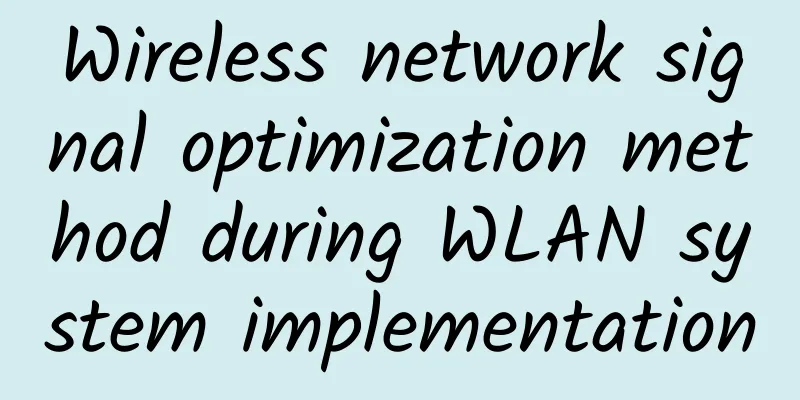Wireless network signal optimization method during WLAN system implementation

|
In project practice, we have spent a lot of money and material resources to build wireless campuses, wireless cities, wireless parks, wireless medical projects, etc., but most of the experiences have more or less poor signals, slow network speeds, inability to authenticate, or either unable to connect or unable to open web pages for a long time after connecting, or frequent disconnection, etc. These phenomena make the user experience very poor, resulting in user dissatisfaction and even complaints. So what is wrong with the wireless WLAN network? What is the culprit for these phenomena?
Generally speaking, there are several factors: design and deployment issues, channel resource issues, limited user capacity of AP, equipment, power supply, transmission issues, etc. 1. Design and deployment issues
2. Channel resource issues
3. Limited user capacity of wireless AP
4. Equipment, power supply, and transmission issues
However, due to the different actual user scenarios, each scenario usually has corresponding wireless signal coverage characteristics and common problems. Usually, according to the deployment of wireless WLAN networks, the actual user scenarios can be divided into the following 7 categories: university scenarios, hospital scenarios, conference rooms or exhibition centers, hotels, leisure and vacation places, transportation hubs, and internal areas of enterprises. The specific wireless WLAN coverage scenario characteristics and common problems are as follows: Wireless WLAN network optimization Optimization steps 1. Network testing Use dedicated testing software to conduct on-site field tests on key aspects of wireless WLAN (such as AP signal strength, signal-to-noise ratio, network delay and packet loss, network throughput, association success rate, WEB authentication delay, roaming stability, same-frequency AP, channel occupancy, etc.) 2. Problem Analysis According to the results of the wireless WLAN network test, analyze the causes of various problems and keep records. For example, in more than 95% of the locations in the design target coverage area, the WLAN coverage receiving signal strength is less than -65dBm. It is found that there are obstacles blocking the site, causing excessive signal loss. Therefore, the signal coverage strength cannot be achieved. 3. Optimization plan According to the cause of the signal problem analyzed in step 2, adjust the installation location of the device, the transmission power or replace the antenna, etc., so as to ensure that the signal coverage strength of the wireless WLAN reaches the required standard value. 4. Network optimization verification After human optimization, we use dedicated testing software to verify on-site at the user site to ultimately ensure that the wireless WLAN meets various performance indicators after optimization. Commonly used wireless WLAN optimization methods: |
<<: Can operators make money without doing anything?
Recommend
Why does 5G need edge computing (MEC)?
[[354637]] This article is reprinted from the WeC...
Virtono adds new Hong Kong data center, 12 data center KVM annual payment starts from 29.95 euros
I received the latest news from Virtono. The merc...
The US 5G license auction amount has reached 69.8 billion US dollars, breaking the historical record
The Federal Communications Commission (FCC) is co...
The 5 keys and applications of blockchain
A few years ago, not many people had heard of the...
Xiao Yaqing: "14th Five-Year Plan" will comprehensively deploy 5G and other infrastructure construction
[[384223]] This morning, the State Council Inform...
Europe focuses on 6GHz rules, Wi-Fi -7 is still a long way off
European regulators have been facing increasing p...
Qorvo Announces Increased RF Fusion20TM Module Availability
[[390846]] Qorvo, a supplier of RF solutions for ...
Lenovo Debuts at Microsoft IoT Conference, Driving Business Intelligence Innovation with Smart IoT Devices
On December 3, the highly anticipated 2019 Micros...
How does 5G help enterprises explore the development of the Internet of Things?
What is the Internet of Things? The “internet of ...
[Black Friday] DediPath VPS Hosting 50% Off, 1Gbps Unlimited Dedicated Server Starting at $45/month
DediPath is a foreign VPS service provider founde...
Servers are attacked for nothing? It’s because the high-defense system is not well-prepared
The development of cloud servers is unstoppable. ...
MoonVM: Hong Kong high-bandwidth VPS monthly payment starting from $10.8, 1GB memory/10G SSD/5TB monthly traffic
The tribe once shared information about MoonVM in...
Happy New Year!
The rat has gone and the ox has come, bringing ne...
Experts give reasons for slow 4G network speed: too many users and bloated apps
Do you feel that the current 4G network speed is ...
Six requirements for integrating SmartNIC/DPU into existing network infrastructure
The CPU has long been considered the backbone of ...









